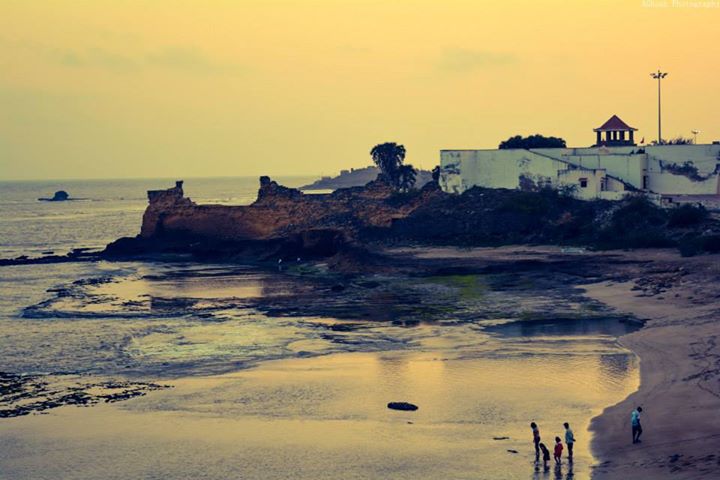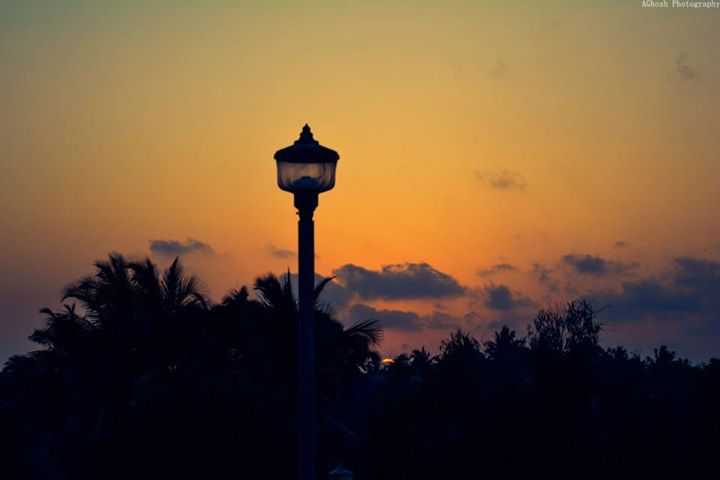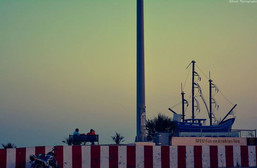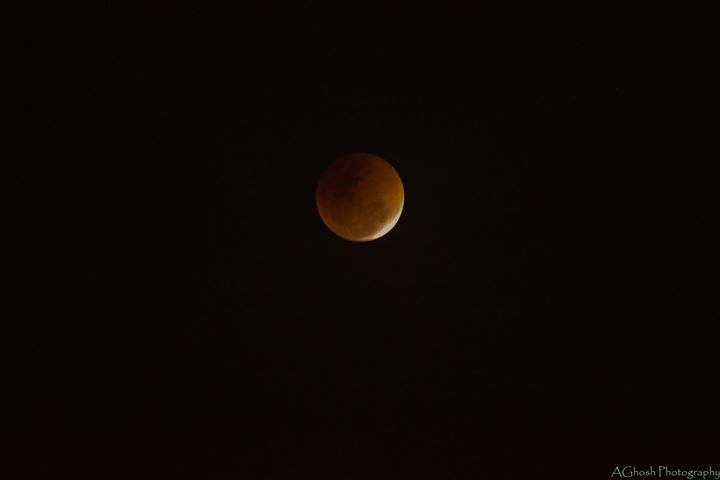This travelogue series is an intimate dialogue with my experiences journaled in a diary in the form of documenting on-the-go. At the same time, I've ensured that this doesn't only become a personal account and can help anyone planning a trip to Diu or otherwise curious about the place with the required insights. If you only need a quick glance of where to stay, what to see, top things to do, you can take a look at the Quick Bite section at the end of the series (Day 4). While I cover most of such salient information in the article, but they are essentially moulded along with the character of the place that I want you to get warmed up with. If you really want to 'see' a place without being there, to scratch beyond the mundane surface details with the spirit of wanderlust and to know those fascinating but lesser-known stories commixed with a place which are elsewhere not so readily available, you are home.
Date: 4.4.2015
The Folklore and Jalandhar Beach
A conceivable glide of humid air. No gormless earth in the vicinity, no movements, no urban hypnosis.
As I stand on the edge of a rock with my bruised knee at #JalandharBeach, named after Jalandhara, the Hindu mythological figure who came into being by the culmination of radiance and fire from Shiva's third eye deflected towards the ocean, I think about the King of Thebes' wife in Greek mythology. Niobe.
Niobe, gifted with seven daughters and seven sons, was believed to be living a happy life with King Amphion until she turned boastful of her fertility and insulted Leto, The Goddess of Modesty and Motherhood, who had only two children, Apollo (The Sun God) and Artemis (Goddess of The Moon and Hunt). Acting on vengeful Leto's instruction, the twins (Apollo and Artemis) killed all children of #Niobe and destroyed the family. While Amphion committed suicide, Niobe lost all hope of living. Dejected, she walked towards Mount Sipylus and continued to wish for her own end, submerged in pain. The Gods of Mercy answered to her prayer finally by turning her into a piece of stone!
They say since that day water sips out from the crevices of that stone during the season Niobe was transmogrified. Popular legend insists that the droplets are Niobe's tears. This tragic Greek tale earned its glorious place in Homer's Iliad as a classic example of how arrogance can lead you to emotions as stoic as a stone. Hamlet too had a mention about it : "Frailty, thy name is woman!—A little month, or ere those shoes were old, ..with which she followed my poor father’s body, like Niobe, all tears. Why she, even she—".
I remember reading somewhere that newborn #Jalandhara pressed Brahma's neck so hard when he went to rescue the child from the sea that tears rolled down from the eyes of The Creator. The child grew up to become a ferocious ruler of the demons. He defeated Hindu deities in battles and went undefeated in front of Lord Vishnu himself. Jalandhara also impersonated Shiva and tried to deceive Parvati in Kailash, triggering Shiva to battle against him, only to get saved and protected due to the virtuousness of his wife, Vrinda. Lord Vishnu had to deceptively tarnish Vrinda's chaste to enable the end of Jalandhara. Vrinda recognized this trick and cursed Lord Vishnu to become a stone!
The black Shaligram Shila (stone) found in river-beds of Nepal's Gandaki river is symbolically worshipped since then as the sacred icon of Lord Vishnu.
Mythologies from different parts of the world are collapsing in unison in front of me at Arabian seashore as I absorb the smell of tranquil oblivion.
Jalandhar Beach, Diu
There's a stone shrine dedicated to Jalandhara somewhere nearby on one of the hillocks. After all, he is believed to be the ruler of #Diu island. How different his stone-carving is from Niobe's stone, I wonder.
I do not move. I do not pay visit to the temple of Goddess Chandrika. My knees are aching due to fall from a rocky escarpment. 'Just cosily nestle in the moment. A little more', I obey the message of sea-breeze.
A firefly, sunset and detour
At a stone's throw distance there stands the INS Khukri memorial, made in tribute to the Indian frigate sunk at the coast of Diu after being fired by Pakistan submarine during the 1971 Indo-Pak war.
The light above has turned a bit dim but the total freedom of a firefly brushes past whispering 'Come along'. Sunset in the month of April typically takes place post 7 PM because Diu is located at Gujarat's southern coast, with a creek separating the island from the mainland. I follow the firefly's gestured call through the measured darkness.
It's a straightforward walk from Jalandhar Beach to memorial. More and more people are flocking towards the #warmemorial to view the #sunset. I realize how much sigh of relief the #Portuguese must have heaved to know that Columbus had not discovered the westward route to India!
I go back from being this close to the memorial and ask the auto driver: 'Will you take me to Chakratirth Beach now? Let's come here later.' He nods. There's an agreement of 5 hour trip (with the wait time) after he picked me up at Nagoa Beach near my stay, close to the minimal hustle and bustle Diu has to offer to its visitors. He will drop me back right there.
There are few autos near the coastline. Keeping the auto booked for 1000 Rs seems almost a necessity for me. The commutation options are very limited if you are not travelling by own vehicle. Auto drivers here show a big placard with standard rate chart to the visitors and are pretty averse to any negotiation. You may hire a scooter or cycle though by paying a refundable security deposit (typically not more than INR 1000) and nominal charges, that's the best option to explore this island which spans around only 13 Km. You may refer to this map to understand the geography better.
The tourism teaser's tagline Ilha de Calma (Isle of Calm) is as close to the truth as it can get, but tourism is yet to take off in Diu. If you plan your visit during Festa de Diu* (typically runs from November to Mid-February), designed to become the longest running beach festival in Asia attracting tourists from different countries, then your experience will differ. Then you can look forward to spend a full moon night in your luxury tent on the beach after enjoying a musical concert or jam sessions, working on some community workshops or attending your favourite adventure events.
It demands some development for this place to become a viable tourist destination as I reckon on my very first day, and I'm not making any insinuation here about the need to commercialize it. Diu just needs to be much more welcoming; otherwise, its romantic disengagement with unblemished natural beauty runs the risk of getting lost in the translation. In short, otherwise more and more people from the neighbouring states will continue to wonder: 'Bro, Daman kaha hai? Woh nehi dikha..!'
It took me no more than 10 minutes to reach to the Chakratirth beach from war memorial through a deserted road.
*I visited Diu and made this observation before the inauguration of Festa de Diu. It seems like Diu tourism recognized the same issue and took steps to improve the vibe.
The reflection on Chakratirth Beach
I am standing on the place where Lord Krishna (and as some insists, Lord Shiva) supposedly killed powerful demon Jalandhara with his Sudarshan Chakra, #ChakratirthBeach.
A vast open space in an #island of rest. The sun's reflection is glistening on the clean water. I open my slipper and walk towards the infinite. The first touch of oceanic cool water on my feet in the ripe summer resembles a kiss with slight pain. My toes cower against the receding current in vain. The earth does displace a bit. Or so it feels.
Chakratirth Beach, Diu
Two men are throwing one kid in the air and catching him before he falls on the wave. A lady is calling them back on the top of her voice from the shore. Familiar sight. The kid seems to be enjoying out there though, full with strange trust. Such trust knows no fear because it doesn't know danger yet.
Some homeless street dogs are loitering with wretched disposition on the sand. There's also a Labrador out there jaywalking by the side of his master. I look at the ocean again, the ebb and flow even out as the palm trees in the surrounding sway with a home-coming purr.
During low tide, one can walk through the water. But today is 4th April 2015, the time of Blood Moon total lunar eclipse, very much visible from India. This is the third of the lunar tetrad (four successive total lunar eclipses, each separated by 1 lunar cycle i.e. 6 months away from the other with no partial eclipses falling in between) of 2014-2015 and I am going to see the shortest total lunar eclipse of 21st century from a clear coastal sky.
A strong tide is coming. The tug in the air is palpable when I head towards #INSKhukri, hoping for less crowd this time.
War Memorial, on the stage with Blood Moon
There are few staircases that you need to climb to reach at the top where a model ship is kept within a glass case, surrounded by a mini garden. You can read more about the significance of the place on Indian Navy Galleries and Indian Express Archive. War stories do not appeal to me at this moment. But then, does that make it any less relevant?
While sauntering towards the beautiful amphitheater right on the top of the sea coming from Jalandhar stretch, one cannot ignore the remains of an erstwhile naval base.
This is by far the most crowded place in Diu, flocked by people of all ages. The spume on rocks created by wave on the potent moonlit night as seen from the inviting amphitheater makes it no less enchanting as a spot though. Also, they maintained this place strikingly clean, in spite of thoughtless waste discard by some blind-to-bin tourists. Come to think of it, Diu is exceptionally clean India.
The undulating light of the moon on ocean does something to me. I catch myself unconsciously muttering Vikram Seth:
'Dark erratic recollection:
the driftwood, pearls and slime;
Love; love's passing; dissipated
ability and time.
Patternless delight and wreckage
without restraint or norm.
Strange, though; even here perhaps one
discerns ingenerate form:
Certainty; pause; the return to uncertainty
as the breakers assaulting the sand
Gather slowly, loose their power,
then ebb away from land.'
War Memorial, Diu
The moon already looks faintly rust-red due to Rayleigh scattering even before eclipse.
Right at the beginning of eclipse phase and just before the end of totality, one can notice a light blue band on moon's surface due to the same reason, but the visible colour of different phases largely depend on atmospheric conditions (presence of dust particles, pollutants etc.). The relatively pollution-free sky offered a nice copper hue during totality.
Blood Moon Total Lunar Eclipse, 4th April, 2015, Diu
I tried to imagine how lunar eclipse looks like from the moon. Gusts of wind makes all physical principles emptier to establish all these are made with so much affection or got created on its own because the only purpose of this grand design can possibly be beauty and terror!
Continued... Day 2
PhotoStory Date: 4.4.2015
Place: Diu island, Union Territory of Daman and Diu
Words and Photographs: Amrita Ghosh
Resource Credit: Diu island map @mapsofindia, links with details on War Memorial @Indian Navy Galleries and @TheIndianExpress story written by Hiral Dave, 'Moonless Night' poem from Vikram Seth's The Collected Poems



















Comments